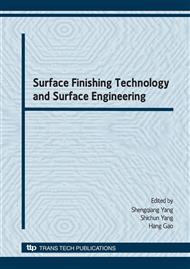p.141
p.147
p.155
p.161
p.167
p.173
p.179
p.185
p.191
Effect of Ice Counterparts on the Friction Behavior of Single Crystal Silicon Wafer
Abstract:
The friction behavior of single silicon wafer sliding against different ice counterparts (α-Al2O3, CeO2 and SiO2) at 10±0.5 °C within a velocity of 60 rpm~300 rpm were studied using a home-made friction and wear testing machine. The morphologies and surfaces roughness of the worn silicon wafers were observed and examined on a non-contact surface topography instrument (ADE). It was found that the friction coefficient of the single silicon wafer decreased with the increase of sliding velocity. Single crystal silicon wafer coupled with α-Al2O3 ice counterpart recorded the highest friction coefficient and the biggest surface roughness, while it had the lowest friction coefficient and the smallest surface roughness as with CeO2 ice counterpart. One reason was that a series of tribochemical reactions occurred at the local contact point between the ice counterpart and the silicon wafer during sliding. Under alkaline condition, there would be a soft corrosion layer formed on the surface of the silicon wafer. Another reason was that the hardness of the abrasive particles was different and this caused different cutting depth of them.
Info:
Periodical:
Pages:
167-172
Citation:
Online since:
July 2008
Authors:
Price:
Сopyright:
© 2008 Trans Tech Publications Ltd. All Rights Reserved
Share:
Citation:


